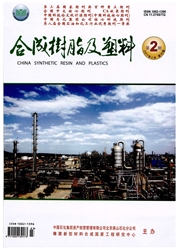

 中文摘要:
中文摘要:
采用恒速型双毛细管流变仪对比研究了均聚聚丙烯(PPH)T30S,嵌段共聚聚丙烯AP3N,无规共聚聚丙烯(PPR)2400和PP-114220熔体在高速挤出流场中的流变特性。PPR在较低速率下,短口模挤出物即出现规则螺纹畸变。相对分子质量相对较小的PPH T30S在高挤出速率下也出现螺纹畸变。分析表明,螺纹畸变的发生源于口模入口区的应力集中效应和次级环流。PPR熔体黏度高,弹性大,入口流动应力集中效应显著,且黏流活化能高,分子链柔性和结构规整性差,这些是导致其容易发生螺纹畸变的因素。
 英文摘要:
英文摘要:
The authors systematically studied rheological behavior of polypropylene melts through high speed extrusion flow field by a constant speed double-capillary rheometer, including propylene homopolymer(PPH) T30S, propylene block copolymer(PPB) AP3N and propylene random copolymer(PPR) 2400 and PP-R4220. Regular helix distortion of PPR extrudates could occur through short die at low extrusion rate, while PPH T30S with lower relative molecular mass could generate helix distortion at high extrusion speed. Analyses show that the helix distortion is caused by stress concentration effect and secondary circulation at the die entrance. The main factors resulting in easily the helix distortion involve high viscoelasticity and viscous flow activation energy of the melts, serious entrance stress concentration and poor flexibility and structural regularity of the molecular chains.
 同期刊论文项目
同期刊论文项目
 同项目期刊论文
同项目期刊论文
 期刊信息
期刊信息
